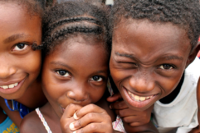Demographics
The African Colombian population in Colombia is mostly concentrated in coastal areas.

72.7% – 100%
45% – 72.6%
20.4% – 44.9%
5.8% – 20.3%
0% – 5.7%
Without data
Afro-Colombian children
In the 1970s, there was a major influx of Afro-Colombians into the urban areas in search of greater economic and social opportunities for their children. This led to an increase in the number of urban poor in the marginal areas of big cities like Cali, Medellín, and Bogotá. Most Afro-Colombians are currently living in urban areas. Only around 25%, or 1.2 million people, are based in rural areas, compared to 75%, or 3.7 million people, in urban zones.
The 1991 Colombian Constitution gave them the right to collective ownership of traditional Pacific coastal lands and special cultural development protections. Critics argue that this important legal instrument is not enough to completely address their social and developmental needs.[9]
Afro-Colombians make up 6.68% of the population, almost 3 million people, according to a projection of the National Administrative Department of Statistics (DANE),[10] most of whom are concentrated on the northwest Caribbean coast and the Pacific coast in such departments as Chocó, whose capital, Quibdó, is 95.3% Afro-Colombian as opposed to just 2.3% mestizo or white.
Considerable numbers are also in Cali, Cartagena and Barranquilla. Colombia is considered to have the fourth largest Black/African-descent population in the western hemisphere, following Haiti, Brazil and the United States.
It has been estimated that only 4.4 million Afro-Colombians actively recognize their black ancestry, while many other African Colombians do not as a result of inter-racial relations with white and indigenous Colombians.[13] Afro-Colombians often encounter a noticeable degree of racial discrimination and prejudice, possibly as a socio-cultural leftover from colonial times.
They have been historically absent from high-level government positions. Many of their long-established settlements around the Pacific coast have remained underdeveloped.[13] In Colombia’s ongoing internal conflict, Afro-Colombians are both victims of violence and displacement as well as members of armed factions, such as the FARC and the AUC. African Colombians have played a role in contributing to the development of certain aspects of Colombian culture. For example, several of Colombia’s musical genres, such as Cumbia and Vallenato, have African origins or influences. Some African Colombians have also been successful in sports.

